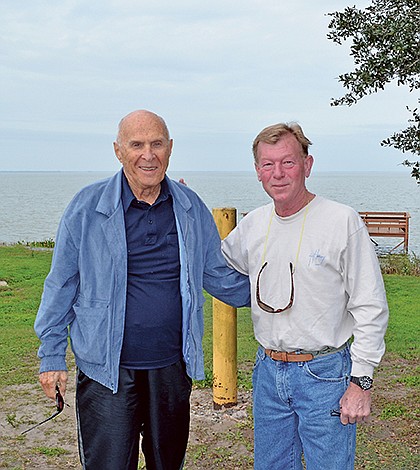- January 16, 2025
-
-
Loading

Loading

OCOEE — Francis Heidrich was 17 when he took the bookkeeper’s position for his father’s fruit and produce business, which had offices in the Tavares, Orlando & Atlantic Railroad depot. While handling the finances for Herman J. Heidrich & Sons, the teen also kept his ears open for a truck horn, which signaled the arrival of fresh produce.
"Many times it was Claude Hawthorne with a load of 48-quart hampers of cabbage or escarole,” said Heidrich, now 94. “I would open the refrigerated car doors, and he would bring a hamper to the doorway of the car, where I would stack them and cut up a 300-pound block with an ice pick into roughly 60-pound chunks from five tons that I had unloaded in the car earlier.”
That Hawthorne was Thomas “Claude,” who was born in 1891 and a founding member of the Ocoee Citrus Growers Association. He was a grower of leafy vegetables, including red cabbage on land now owned by the Manheim Orlando auto auction. His son was William “Billy” Hawthorne, and his grandson is Milton “Claude” Hawthorne, all of whom have lived on the family property in Minorville that was purchased in the 1880s. The grandson lives there today.
Francis Heidrich and the younger Claude Hawthorne got together recently to reminisce about “old Ocoee” and the days of railroading and farming.
SHIPPING FROM OCOEE
Heidrich’s father, a wholesale fruit and produce businessman in Philadelphia, came to Winter Garden in 1932, during the middle of the Great Depression, to seek a better life for his family. He stayed at the Edgewater Hotel in Winter Garden for $30 a week, including meals. It would be three years before he would bring his family south.
The Heidrichs lived at the corner of Anderson Street and Rosalind Avenue for a few years. This land, incidentally, was part of 20 acres of a pineapple farm owned by P.H. Britt, of Winter Garden, at the turn of the 20th century.
The elder Heidrich opened his office in the railroad depot, with its long loading platform and two offices, financing and marketing the product of vegetable growers in the area, including names such as Hawthorne, Maguire, Bennett, Freeman, Tilden, Sadler, Cannon, Britt, McMillan, Seidel, Austin, Karst and Pounds.
His father rented a small citrus packinghouse belonging to Bill Pease in Ocoee in the late 1940s, but it wasn’t large enough, so he moved the entire operation in 1948 to Robinson Street in Orlando. This was across the railroad tracks from the office of citrus magnate Dr. Philip Phillips.
Heidrich said: “Dr. Phillips picked my dad up in his limousine and took him to Howard Johnson’s for lunch. The purpose was to see if Dad was interested in buying his groves.”
When Herman J. Heidrich & Sons outgrew its Robinson office, a 60,000-square-foot packinghouse was built on Highway 441 near Rosemont.
“By the mid-’60s, we were the largest fresh fruit shipper in the world,” Heidrich said.
His father also developed what he called Heidrich’s Put-Put Ice Bunker Refrigeration.
He described the device: “A partition with a 12-inch vent in the bottom was put across the front of the 24-foot semi-trailer. A large fan was then installed at the top of the partition, and the fan received its power from a Briggs & Stratton small engine mounted on the outside of the trailer. The purpose was to blow the cold air across the top of the load and then be sucked into the bottom of the bunker and up through the ice to refrigerate the air circulating through the load.
“In the process, we became the world’s largest fresh peach shipper,” he said.
His father expanded his business and became a grower in 1948, planting citrus near Reunion and Walt Disney World.
MAINTAINING THE HOMESTEAD
There’s a lot of history surrounding Claude Hawthorne’s house in the Minorville area of Ocoee, east of Bluford Avenue and north of West Colonial Drive. Orange groves circle the property, and machinery from days gone by dots the yard. The weathered remains of a nursery expose a metal skeleton, and a house once occupied by Hawthorne Grove Service supervisors sits to the northeast, nearly swallowed by trees.
His great-grandfather, James P. Hawthorne, started planting citrus groves in 1889 on the land along Maine Street, once a historic brick road that was the original route to Orlando, off Bluford. The family business eventually operated the oldest overhead irrigation farm in the world, Claude Hawthorne said, and the property still has one of the oldest farm seepage wells in the area.
A seedling grove once wrapped around his grandmother’s house, and he remembers the seeding trees grew quite tall.
“When I was a kid, I had to stand on the roof of my father’s truck to even think about touching the bottom leaves,” he said. “Why don’t we grow them like that today? They’re full of seeds; a lot of the fruit drops before it gets ripe.”
A series of freezes damaged some of the citrus groves, but it wasn’t a complete devastation for the family.
“Thank God Claude had cabbage-growing,” Hawthorne said.
The Hawthorne and Minor families merged when Mary Lucy Farmer (whose mother was Daisy Minor) married Thomas Claude Hawthorne. In another connection, Eliza Griffin “Lide” Hawthorne married William J. “Jack” Minor.
CREATING MINORVILLE
Longtime Ocoee residents still refer to the area as Minorville, although it was never incorporated and had, at most, eight families living there.
Contact Amy Quesinberry Rhode at [email protected].